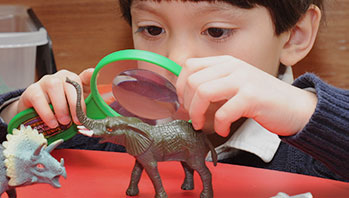- hoops or sorting trays
- toy zoo animals or animal pictures
- animal
- loud
- quiet
- sound
MA Standards:
Mathematics/Measurement and Data/PK.MD.MA.3: Sort, categorize, and classify objects by more than one attribute.
Head Start Outcomes:
Approaches to Learning/Cooperation: Plans, initiates, and completes learning activities with peers.
Logic and Reasoning/Reasoning and Problem Solving: Classifies, compares, and contrasts objects, events, and experiences.
MA Draft STE Standards:
Physical Sciences/Matter and Its Interactions/PS1.A: Describe, compare, sort and classify objects based on observable physical characteristics, uses, and whether it is manufactured as part of their classroom play and investigations of the natural and human-made world.
PreK Guidelines:
Mathematics/Patterns and Relations 8: Sort, categorize, or classify objects by more than one attribute.
Sort Loud and Quiet Animal Sounds

© Commonwealth of Massachusetts, Department of Early Education and Care (Jennifer Waddell photographer). All rights reserved.
Skill Focus: Comparing, Sorting and Classifying, Speaking and Listening, Vocabulary
Have children decide which hoop or sorting tray is for loud animals and which is for quiet animals.
Then have children work together. Have partners choose two animals and compare the sounds they make using the vocabulary they have been learning to describe sounds, for example, bear/mouse: grumbly loud/squeaky soft; lion/tiger: loud roar/loud roar.
Guide children by asking questions such as, “Do bears ever make soft sounds? Do mice ever make loud sounds?”
- After all animals have been classified, have children take each animal out of the box and act out the animal and the sound it makes.
